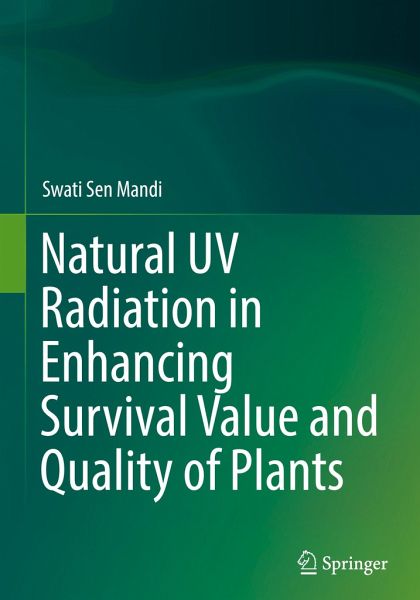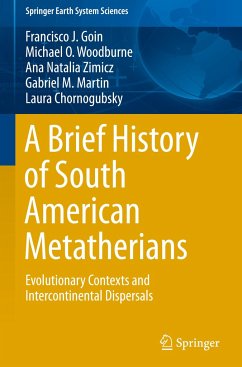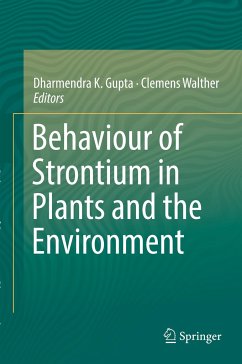
Natural UV Radiation in Enhancing Survival Value and Quality of Plants
Versandkostenfrei!
Versandfertig in 6-10 Tagen
113,99 €
inkl. MwSt.
Weitere Ausgaben:

PAYBACK Punkte
57 °P sammeln!
Thisbook is the first of its kind to highlight the positive impact of natural UVradiation on plants through unique adaptations in various metabolic pathways, andprovides an evolutionary sketch of the development of molecular mechanisms forprotecting plants from solar UV ever since their migration to terrestrialhabitats. Experimental evidence is provided for establishing how plants, throughtheir stationary habit in the open field, survive and flourish by developing suitableUV acclimation strategies through the repair of damaged macromolecules and/orupregulation of screening compounds viz. flavo...
Thisbook is the first of its kind to highlight the positive impact of natural UVradiation on plants through unique adaptations in various metabolic pathways, andprovides an evolutionary sketch of the development of molecular mechanisms forprotecting plants from solar UV ever since their migration to terrestrialhabitats. Experimental evidence is provided for establishing how plants, throughtheir stationary habit in the open field, survive and flourish by developing suitableUV acclimation strategies through the repair of damaged macromolecules and/orupregulation of screening compounds viz. flavonoids. Presenting an analysis of relatedliterature, it also highlights the importance of outdoor experiments over thosein closed chamber under artificial UV light for obtaining realistic data.
The book presents a comprehensiveaccount of the stratospheric ozone layer, its formation and seasonal thinning,with particular reference to alarming anthropogenic destruction of the ozonelayer since the last quarter of the twentieth century, which has resulted in increasedUV fluence on Earth. It discusses variations in the hazardous impact of UV onlife at different latitudes through the ages, and examines altitudinal variationsin UV effects in case studies demonstrating high antioxidant content and aromastatus in Darjeeling tea leaves (at high altitudes) compared with those of the sametea clones in Assam leaves (at low altitudes), with both sites being at the samelatitude. It provides evidence which suggests that the UV effects relating tothe expression of seed vigour-viability could be epigenetic.
Further, it presents recently developed microscopictechnologies for demonstrating the penetration of UV into plant cells, and discusseshow cellular metabolism can be affected either directly or via signaltransduction. Effect of damage in DNA (the key target of UV radiation) has beendemonstrated and estimated using precise techniques. The latest "FOX Hunting"technique as a useful means of transcriptome analysis that may be used fordeveloping UV tolerant plants through Marker Assisted Breeding has also beendiscussed. Using biochemical and biotechnological methods, the experimentspresented highlight the gene X environment based upregulation of specificmetabolic pathways, allowing i) value addition in plant-derived food, and ii) pavingthe way for the industrial manufacture of Alternative Medicine products. Thebook is enriched by a critical review of the available literature andappropriate case studies selected from the author's own findings, which span nearlyfour decades of active research.
The book presents a comprehensiveaccount of the stratospheric ozone layer, its formation and seasonal thinning,with particular reference to alarming anthropogenic destruction of the ozonelayer since the last quarter of the twentieth century, which has resulted in increasedUV fluence on Earth. It discusses variations in the hazardous impact of UV onlife at different latitudes through the ages, and examines altitudinal variationsin UV effects in case studies demonstrating high antioxidant content and aromastatus in Darjeeling tea leaves (at high altitudes) compared with those of the sametea clones in Assam leaves (at low altitudes), with both sites being at the samelatitude. It provides evidence which suggests that the UV effects relating tothe expression of seed vigour-viability could be epigenetic.
Further, it presents recently developed microscopictechnologies for demonstrating the penetration of UV into plant cells, and discusseshow cellular metabolism can be affected either directly or via signaltransduction. Effect of damage in DNA (the key target of UV radiation) has beendemonstrated and estimated using precise techniques. The latest "FOX Hunting"technique as a useful means of transcriptome analysis that may be used fordeveloping UV tolerant plants through Marker Assisted Breeding has also beendiscussed. Using biochemical and biotechnological methods, the experimentspresented highlight the gene X environment based upregulation of specificmetabolic pathways, allowing i) value addition in plant-derived food, and ii) pavingthe way for the industrial manufacture of Alternative Medicine products. Thebook is enriched by a critical review of the available literature andappropriate case studies selected from the author's own findings, which span nearlyfour decades of active research.












